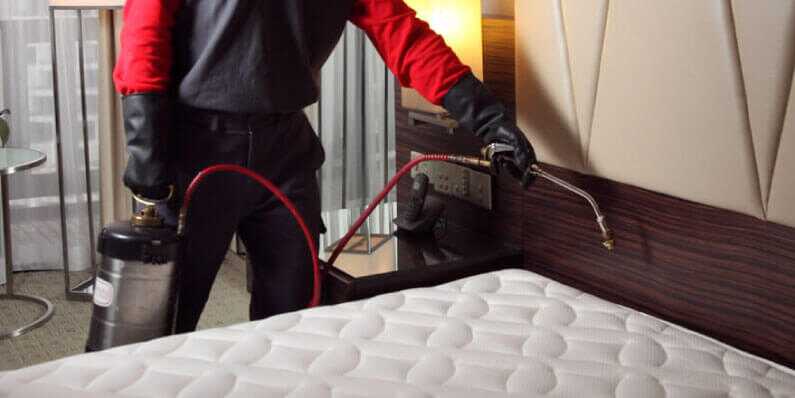Premier Bed Bug Exterminator: DC Exterminator for Effective Treatment
Premier Bed Bug Exterminator: DC Exterminator for Effective Treatment
Blog Article
Discovering the Science Behind Bed Insect Warmth Treatments as a Sustainable Bug Management Method
One such method that has gained grip in current years is the usage of warm treatments to fight bed bug infestations. The intricacies of just how heat effectively removes bed pests and the wider ramifications for sustainable pest monitoring methods make this a topic worth exploring better.
Bed Pest Warm Treatment Process

Thermal Death Point for Bed Insects
Exposing bed bugs to raised temperature levels beyond their thermal tolerance range is crucial for attaining reliable elimination in warm treatment procedures. The thermal death point for bed pests refers to the temperature at which these parasites can not make it through. Research shows that bed insects start to die when subjected to temperatures over 113 ° F(45 ° C) for a continual period. As the temperature level enhances, so does the mortality price of bed bugs. At around 118 ° F(48 ° C ), bed pests begin to pass away quickly, with a mortality price of nearly 99% within mins of exposure. This shows the sensitivity of bed pests to heats and highlights the effectiveness of warm treatments in removing infestations. By getting to and maintaining temperature levels above the thermal death factor for bed insects, parasite administration specialists can guarantee thorough elimination of bed insect populations, consisting of hard-to-reach areas where chemical treatments may be much less reliable. Comprehending the thermal fatality point for bed insects is necessary for carrying out effective warmth treatment techniques and accomplishing sustainable pest administration outcomes.
Benefits of Warmth Treatments
Having actually developed the important thermal fatality point for bed insects, it is critical to currently check out the considerable advantages that heat treatments supply in properly getting rid of these resistant bugs. Warm treatments present numerous crucial benefits when compared to typical chemical approaches. One of the primary benefits is that warm can penetrate deep right into holes and fractures where bed bugs conceal, guaranteeing that even one of the most hard-to-reach areas are warmed to deadly temperature levels. This detailed method not just kills real-time insects yet likewise targets bed bug eggs, stopping future infestations.
In addition, heat treatments are environmentally friendly and safe, making them a lasting pest management method. Unlike chemical pesticides, warmth therapies do not leave hazardous residues that can present threats to human health or the environment. This aspect is especially crucial in delicate settings such as hospitals, schools, and domestic areas where chemical use may not be desirable.
Additionally, heat treatments have a high success rate in eliminating bed bug infestations in a single treatment, reducing the need for multiple gos to company website and reducing disruption to residents. This efficiency not only conserves time and cash yet likewise supplies satisfaction to those taking care of bed insect problems.
Effectiveness of Heat Therapy

Warm treatments have the included benefit of killing bed pest eggs, which are usually immune to standard chemical treatments. Overall, the performance of warm treatments in eradicating bed pest invasions makes them a reputable and sustainable pest monitoring method.
Sustainable Parasite Administration Benefits
Implementing sustainable bug monitoring practices provides long-lasting advantages for both the setting and public health. By using techniques such as warmth therapies for parasite control, we can reduce the reliance on damaging chemical pesticides that can have damaging results on ecosystems and human health and wellness - bed bug heat treatment. Lasting parasite monitoring strategies help in preserving biodiversity by targeting specific pests without harming non-target organisms, thus preserving a balanced community
Additionally, sustainable insect management practices add to the total health and wellness and wellness of the public. By minimizing direct exposure to harmful chemicals made use of in conventional insect control techniques, warmth treatments give a much safer option for insect administration in household, industrial, and public spaces. This decrease in chemical usage additionally helps in avoiding pesticide residues from polluting dirt, air, and water, securing ecological quality.
Conclusion
Finally, bed pest heat therapies have been revealed to be a sustainable and efficient bug monitoring method. The thermal death factor for bed bugs makes them at risk to warm treatments, which have countless advantages over typical chemical treatments. The efficiency of warmth treatments in removing bed insect infestations while lessening ecological effect highlights the possibility of this method as a sustainable remedy for insect control.
The bed bug warm therapy process includes elevating the temperature within plagued locations to a level that properly eliminates bed insects and their eggs. By getting to and keeping temperatures above the thermal fatality factor for bed bugs, bug monitoring professionals can make sure thorough removal of bed bug populations, including hard-to-reach locations where chemical therapies may be less effective. One of the main benefits is that warm can pass through deep right into cracks and gaps where bed pests conceal, ensuring that even the most hard-to-reach areas are heated to deadly temperature levels. Unlike chemical therapies that might leave behind immune populaces, warm therapies use a safe and eco click here to read friendly remedy that can pass through deep right into furnishings, wall surfaces, and various other hard-to-reach locations where bed insects conceal.
The thermal death point for bed bugs makes them susceptible to heat therapies, which have countless advantages over traditional chemical therapies.
Report this page